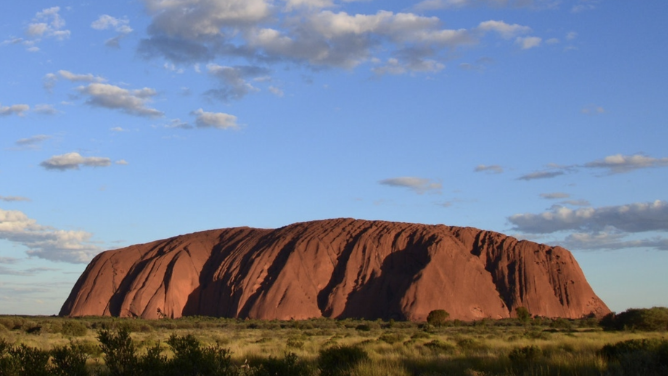G’day, The winter school holidays in Australia are the perfect time for families to visit Uluru, with mild daytime temperatures and lots of sunshine to help you shake off the mid-year blues. To make the most of your trip to the Red Centre, our team of knowledgeable, expert guides have compiled their list of the top six things you should know before you visit with SEIT Tours. Six Things You Should Know About Uluru Before You Visit The Red Centre!
1. The History of Uluru
In 1873, surveyor William Gosse sighted ‘the rock’ and, in honour of the then Premier of South Australia, Sir Henry Ayers, named it Ayers Rock. In 1993, Uluru became the first icon in Australia to be given back its Aboriginal name. These days, while it’s officially called Uluru / Ayers Rock, most people call it Uluru.
However Aboriginal people have lived in the area around Uluru and Kata Tjuta for at least 30,000 years. For Anangu, their culture has always existed here. The Central Australian landscape is believed to have been created at the beginning of time by ancestral beings.
For the local Anangu people, the creation of Uluru and Kata Tjuta forms part of their Tjukurpa, or creation story and the marks left behind by their creation ancestors form part of the laws they live by and keep to this day.
The protection and management of the lands around Uluru and Kata Tjuta are considered to be intrinsic Anangu responsibilities, and the traditional stories and spirituality of the area which is now a National Park remain an important part of their enduring culture to this day.
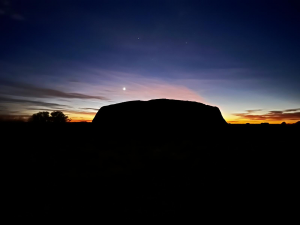
2. The Art and Culture surrounding the Red Centre
One culturally significant place is Mutitjulu Waterhole, where you are surrounded by the presence of and will learn about two ancestral beings – Kuniya, the python as well as Liru the venomous snake. These stories are passed down through Tjukurpa which is the foundation of Anangu culture. It is the spirituality, law and story that link Anangu to their ancestors and the environment.
There is an incredible amount of Indigenous Australian art and culture surrounding the Red Centre. Our experienced tour guides give you the chance to learn about Aboriginal stories and ancestral beings, learn the importance of local art and discover the significance of the several walks available.
3. Uluru is home to a lot of wildlife!
Uluru is home to 400 plant species. Anangu uses many different parts of plants and animals to ensure no resource would go to waste. For example, the Wanari (Mulga) tree is the main source of firewood for cooking and smoking meat. The larger branches can be used as spear throwers, boomerangs as well as sticks! The leafy branches are used to make shelters and windbreakers.
Maku means edible grubs. They’re white in colour and are found in the roots of trees and are tasty and a source of protein too!
On our SEIT PATJI – A true Aboriginal Experience tour you will learn the many uses of various plants for food and even medicine!
With 170 different animal species calling Uluru home, our experienced guides will spot them for you along your journey. Keep an eye out for the Thorny Devil, it’s a small dragon covered in densely packed spikes. It walks with an unusual rocking motion which can confuse the birds that prey on them.
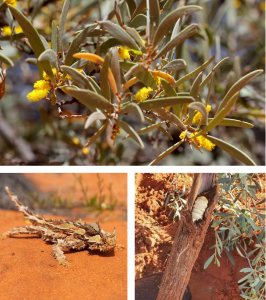
4. You can’t climb Uluru!
To respect the traditional owners, climbing the summit was officially banned in 2019. However, a walk around the 9km perimeter will have you encountering a plethora of sacred Indigenous sites and art.
The Anangu people are the traditional owners of Uluru and the land it sits on. To them, Uluru isn’t just a rock formation, but a living, being, spiritual and sacred place that must be respected.
However, get your walking shoes on because a walk around the 9km perimeter will have you encountering a plethora of sacred Indigenous sites and art.
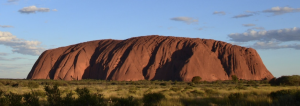
5. Uluru–Kata Tjuta National Park is a World Heritage Site
Uluru–Kata Tjuta National Park is renowned for its exceptional natural environment and the living culture of its traditional Aboriginal owners, known as Anangu. The park is on the World Heritage List under the World Heritage Convention for its outstanding cultural and natural values, and this comes with international obligations to protect these values.
6. The Red Centre can be pretty green
While rain can fall anytime, heavy rains are likely between November and March. However, we have seen heavy downpours in May. With the changes in season, we can get quite a bit of rain, with our yearly average at 30.48cms. There is nothing like a rain shower and waterfalls to brighten your tour!
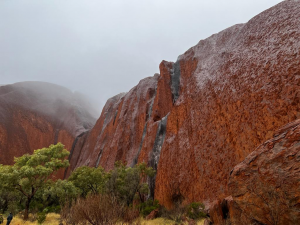
For more information on our tours can be found in the links above. Otherwise, for a range of touring options around central Australia, feel free to browse our website.



